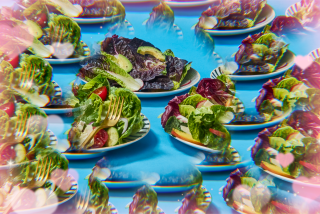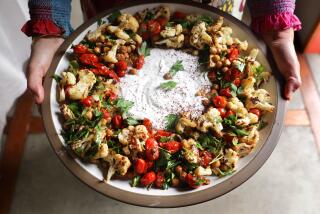The New Greens: A Gardener’s Guide : Plantings: Both <i> mesclun </i> and <i> misticanza </i> are chosen to stimulate the full spectrum of your taste buds.
- Share via
Fancy display baskets of pastel green and pink baby salad greens and edible flowers are enticing shoppers in upscale produce markets. The label over the baskets say “Mesclun” or “Gourmet Salad Mix,” and the prices can be an eye-popping $8.95, even $12.95 a pound!
What is this salad blend? Why is it so expensive? Can you grow it? And how do you prepare it?
To give you a quick primer, mesclun is a traditional salad from Southern France; it is composed of an artful selection of tasty baby lettuce and a vast range of very young salad greens. A closely related salad from Italy is known by the name misticanza .
The appeal of both mesclun and misticanza is the depth of flavors and textures produced when greens are chosen to stimulate the full spectrum of your taste buds. The tastes are tangy, slightly bitter and sweet, and the textures are crunchy and velvet-like. A salad now becomes a concert for the mouth.
The price of mesclun is so high because the greens must be picked and sorted by hand and because they’re so very perishable. Fortunately, they’re very easy to grow, and mesclun is fast becoming a favorite with gardeners.
“Through the centuries, different greens were grown in the garden or collected in the wild,” explained Georgeanne Brennan, co-owner of Le Marche, a wholesale seed business. “And over the years the French refined these combinations. While many French people still grow their own salad greens today, market gardeners offer mesclun to the general public.
“In Nice, for instance, you see piles of different little mixed greens and herbs for sale by weight. One seller might offer a mix with nine ingredients, another five, but the principal selections will include all the elements: peppery rockets, bitter chicory, tender butterhead, somewhat crunchy romaine and slightly anise-tasting chervil. Over the years, because I missed mesclun when I moved back to the States, I grew the mix myself and it’s very easy.”
Mesclun , however, is not only a traditional salad mix, it’s also a concept. Here in the United States, chefs and market gardeners have expanded on the European concept and are giving mesclun a decidedly American flavor.
California chef Doug Gosling grows what he calls a deluxe mesclun mix, including the traditional ingredients as well as Colonial American favorites such as red and yellow orach, Ragged Jack kale, good king Henry and many heirloom lettuces of various shapes and colors. He also includes Oriental favorites such as mizuna, pac choi and Japanese red mustard; edible flowers including nasturtiums, calendulas and borage; and a vast array of unusual herbs, from tri-color sage to bronze fennel.
One of the unusual aspects of mesclun greens is the way they are usually grown. Most Americans grow rows of lettuce and greens, thin them, wait to maturity and then harvest the whole plant. In contrast, mesclun plantings are seeded over a two- or three-foot-wide bed and rarely thinned. Leaves from the plants are harvested by hand or with scissors when they are two or three inches tall, by what’s called a cut-and-come-again method.
The easiest way to plunge into growing mesclun is to order a mixed selection of seeds from a seed company. There are different types of mesclun mixes. Some are very tangy, others are mild. The catalogues will give you a full description of their mixes.
All types of varieties and greens can be purchased in a mixed package and planted all in one bed, or the seeds can be purchased in individual packages and planted in their own rows and then mixed in the salad bowl instead. A well-grown garden bed of about 50 square feet will provide a suitable amount of mesclun for a family of four for a season.
The secret to growing great mesclun is to prepare the soil well before planting. In spring, choose a sunny area of the garden with well-drained soil. If it’s late spring and quite warm, choose a spot that gets afternoon sun.
Remove weeds from the area, dig in three or four inches of compost or manure and a few cups of blood and bone meal. Mix it in well. Rake out the lumps and sprinkle the seeds over the bed so they are about 1/2 inch apart. Barely cover the seeds with a little compost and gently water the seed bed. If you have no garden space, obtain a large planter at least 3 feet long or 3 feet in diameter. Buy potting soil at the nursery, add a little fertilizer and plant in that instead.
If you think birds will eat the seedlings or cats will dig in the bed, put bird netting over it. Keep the bed evenly moist for a few days until the seeds sprout. From then on, the secret to growing succulent greens is keeping them growing vigorously by keeping the bed fairly moist and giving the greens a light application of a liquid organic fertilizer after the first harvest; otherwise the greens can get bitter or tough.
You can begin harvesting when the plants are about three inches tall. Andrea Crawford of Los Angeles, who grows salad mixes for Spago and New York’s Four Seasons, uses scissors to snip across the bed, about an inch above the crown where the stems come out. You won’t kill the plants unless you go too low and cut the crown. Wash and sort the greens, dry in a salad spinner, place between a few paper towels and refrigerate them.
Mesclun salads are traditionally dressed with a vinaigrette of wine or balsamic vinegar and olive oil.
When combining less traditional vinaigrette ingredients, many chefs use the fairly mild, light olive and salad oils, and rice wine, Champagne and Sherry vinegars for mild greens such as lettuce, mache and miner’s lettuce; they then combine them with mild herbs such as parsley, basil, chervil and thyme. Try the heavier Kalamata (Greek) olive oil and walnut oils, and balsamic vinegar for hardier greens such as kale, cress and radicchios combined with intense herbs such as sage, rosemary and marjoram.
A simple vinaigrette is the traditional, and certainly it’s my favorite way to dress a mesclun salad.
CLASSIC MESCLUN SALAD
1 tablespoon wine or balsamic vinegar
3 tablespoons olive oil
1 teaspoon Dijon mustard
1/2 teaspoon crushed garlic
1 teaspoon chopped fresh herbs
Salt
Freshly ground pepper
Mesclun greens, about 1 handful per person
Pour vinegar into small jar. Add olive oil slowly and stir rapidly until mixture is emulsified. Add mustard, garlic and herbs. Season to taste with salt and pepper. Adjust seasonings to taste. Wash greens and dry in salad spinner or blot dry with paper towels.
Just before serving, place greens in large bowl and pour over half of vinaigrette, tossing lightly. (Baby greens are delicate and can easily be overwhelmed by taste and sag from weight of too much dressing; add on light side when adding rest of vinaigrette.) Makes 4 servings.
Carole Saville, food and garden writer from Los Angeles, serves the following salad in the spring and early summer. In the fall, she uses fresh Comice pears and garnishes the dish with calendula petals instead of violets.
MESCLUN WITH WHITE WINE-PEAR VINAIGRETTE
3 to 4 handfuls baby, Marvel of Four Seasons and Oak Leaf lettuce
1 handful mache
Leaves from 4 sprigs salad burnett
8 to 12 young violet leaves
1/2 to 1 tablespoon chopped sweet cicely, tarragon or chervil
8 to 12 small leaves Alaska or standard nasturtiums
White Wine-Pear Vinaigrette
4 peeled and cored or canned pear halves)
1/4 cup chopped walnuts
8 to 12 violet flowers, organically grown
Wash baby lettuces, mache, salad burnett, violet leaves, cicely and nasturtiums. Dry in salad spinner or blot carefully with paper towels. Place greens in large bowl. Cover and chill.
Just before serving, dress greens with vinaigrette. Divide among 4 plates. Cut each pear half into 3 or 4 slices and fan slices out onto each plate. Sprinkle pears with chopped walnuts and violets. Makes 4 servings.
White Wine-Pear Vinaigrette
2 tablespoons white wine vinegar
2 teaspoons canned pear nectar
1/4 cup walnut oil
2 tablespoons canola oil or salad oil
Salt
White pepper
Dash nutmeg
2 to 3 teaspoons pink peppercorns, crushed, optional
Combine wine vinegar, nectar, walnut and canola oils in small carafe. Season to taste with salt and white pepper. Add nutmeg and peppercorns.
More to Read
Eat your way across L.A.
Get our weekly Tasting Notes newsletter for reviews, news and more.
You may occasionally receive promotional content from the Los Angeles Times.










